our
CENTRE & ACTIVITIES
Sri Petaling
Yayasan Pema Norbu Vihara Malaysia
No. 55-3 Jalan Radin Tengah
Bandar Baru Sri Petaling
57000, Kuala Lumpur, Malaysia
- THE CENTRE
- ACTIVITIES
YPNV runs the official Malaysian Palyul Centre in Sri Petaling , a suburb 20 minutes from the heart of Kuala Lumpur. Nestled on the third floor of a shophouse in the bustling heart of Sri Petaling, the YPNV Centre provides an oasis of calm for practitioners to come together to learn the dharma and the practices of the Palyul school.

Upon entering the YPNV Centre, visitors will find themselves in the Shrine Hall where Guru Rinpoche, Amitabha Buddha and Avalokitesvara Sadaksari, watch benevolently over the activities of the centre.
The traditional etiquette is to prostrate 3 times facing the altar. If you are new to Tibetan Buddhism, and are not comfortable doing so, you may also bow with your hands folded towards the altar. Visitors are welcome to make offerings at the altar. Learn more about making offerings here.
An altar, in the Buddhist tradition, is meant to be a reminder of the goals of Buddhist practice. As such items placed on the altar are placed there to remind us of enlightened body, speech and mind. The exact items on altars differ amongst the different Buddhist traditions, but in general the most basic items are items that represent the Three Jewels of Buddhism. The YPNV Centre altar is based on the traditions of the Palyul lineage.
Please point the cursor at each item on the altar to identify it.
The Lotus Family Trinity
The Lotus Family trinity make up the focal point of the altar. The Lotus Family Trinity is made up of Amitabha Buddha, Padmasambhava or Guru Rinpoche and Avalokitesvara Sadaksari. The Lotus Family is one of the five Buddha families in Tibetan Buddhism, and represents purification. The lotus is also an important symbol in Buddhism as it represents trancendance over the dirt and mud of ignorance into enlightenment. The Lotus Trinity also represents the three manifestations/ emanations of Buddha based on the Trikaya doctrine, that is the nirmanakaya (Guru Rinpoche), sambhogakaya (Avalokitesvara Sadaksari) and dharmakaya (Amitabha Buddha).

Amitabha Buddha is one of the Five Dhyani Buddhas and represents purification of desire and attachment.

Guru Rinpoche brought Buddhism to Tibet and is the founder of the Nyingma school. He is considered an emanation of Amitabha Buddha. You may wonder why Guru Rinpoche is the focal point of the altar. In Tibetan Buddhism, it is customary for the lineage master to be the focus point of the altar. For the Palyul lineage, which is part of the Nyingma school, the lineage master is Guru Rinpoche. Guru Rinpoche is also considered the Second Buddha of this age in Tibetan Buddhism after Shakyamuni Buddha.
Lastly, based on the Nyingma tradition, Guru Rinpoche represents the Three Jewels of Buddhism – his mind is Buddha, his speech is dharma and his body represents the sangha.

Avalokitesvara is a bodhisattva of compassion closely associated with Amitabha Buddha. There are many manifestations/ emanations of Avalokistesvara. Malaysians may be most familiar with Avalokitesvara’s emanation as Kuan Yin, the Goddess of Mercy. Avalokitesvara Sadaksari is associated with the six syllable mantra om mani padme hum, and is thus also known as the Lord of the Six Syllables.
Butterlamp/ Lamps
The butterlamp, or lamp, together with the 7 seven offering bowls make up the most basic items of a Tibetan Buddhist altar. The lamp is usually placed between the 4th and 5th offering bowls, and the offer of the lighted lamp represents the illumination of wisdom.
The Eight Auspicious Symbols
The eight auspicious symbols are widely used in Tibetan Buddhism. These symbols are believed to be the offerings the gods made to Shakyamuni Buddha after his enlightenment.
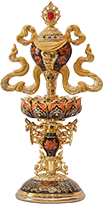
The conch shell, usually a rare right-coiling shell, is a symbol of the far reaching sounds of dharma awakening us from our ignorance
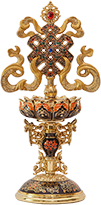
The endless knot symbolises the nature of reality, where everything is inter-related and inter-dependent in the web of karma. As there is no beginning or end to the knot, it also represents the infinite wisdom and compassion of the Buddha.

In Tibetan Buddhism, the ocean is a symbol of suffering. The fish represent how with the dharma, we can, like the fish swim freely and fearlessly in this sea of suffering and migrate (be reborn) freely and easily from place to place.

The parasol symbolises the protection that the dharma gives us from our suffering, as the parasol protects us from the heat of the sun.
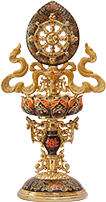
The wheel symbolises the teachings of Buddha, in all realms and at all times, enabling all beings to experience the joy of wholesome deeds and liberation. The wheel usually has eights spokes symbolising the Noble Eightfold Path.
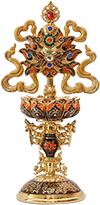
The lotus flower has long symbolised the rise out of the muck of ignorance and suffering to attain enlightenment.
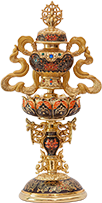
The vase symbolises the inexhaustible riches of the Buddha’s teachings.

The Victory Banner symbolises the Buddha’s victory over Mara, the Lord of Illusion. More generally it symbolises the victory of Buddha’s teachings over ignorance.
Seven offering bowls
The seven offering bowls, are one of the most basic requirements for an altar in the Tibetan Buddhist tradition. Together with the butterlamp placed between the 4th and 5th bowl, they each represent a type of offering : argham, fresh water for drinking; padyam, perfumed water for bathing; pushpe, flowers; dhupe, incense; aloke, light; gendhe, perfume; nevidya, celestial food; and shapda, music.
Usually an offering of water is made in these bowls, the idea being we should always give as freely as we give water, water being a commonly available item that is easy to give.
Tormas
Tormas are offerings that symbolise food. Tormas can also represent deities. Originally made from dough, or butter, contemporary mass produced tormas are now made from clay, wood and other synthetic substances. Each torma is made-up of 3 main parts – foundation, body and decoration, each representing the qualities of body, speech and mind. Tormas are usually made or decorated specifically to be dedicated to specific deities.
Mandala Offering
The mandala offering represents the offering of the entire universe with all its precious and auspicious substances.
Bhumpa
The Bhumpa is a representation of the Treasure Vase. It carries the holy nectar (usually saffron water) for the purification of shrine offerings and initiation.
The making of offerings is a way to practice detachment from worldly possesions. This serves as an antidote to greed. If you would like to make an offering, the 7 traditional offerings are drinking water, bathing water, flowers, incense, light, perfume and food.
Visitors are welcome to make offerings of flowers, food (fruits), incense and light at the altar.
To make your visit to the centre a pleasant one for yourself and for others at the centre, we would appreciate if you could observe the following:
- Please remove shoes and hats before entering the centre.
- Please avoid wearing revealing clothes out of respect for the Shrine Hall.
- Please do not step in front of people making prostrations, or over them.
- Please refrain from speaking too loudly.
- Please help us keep the centre clean and tidy.
- During talks and classes,
a) Please arrive early to avoid disrupting the class.
b) Please rise when the teacher enters the room, and rise again when the teacher leaves.
c) Please do not leave dharma books on the floor or on chairs. Out of respect for the truths they
contain, they should be placed on tables or shelves. - When meeting a Rinpoche/lama/ teacher,
a) In general, remember that the basic rule of conduct is courtesy and respect.
b) The traditional Tibetan way of greeting is the offering of a white scarf or khata.
c) For very high lamas, or one’s own teacher, it is traditional to prostrate 3 times upon arriving and once upon leaving in formal situations. However, if you are uncomfortable with prostrations, a polite bow or a handshake will do.
d) Address the lama by his title – Rinpoche, Khenpo or Lama
Background Photo Credit:
Untitled via Pixabay
















































